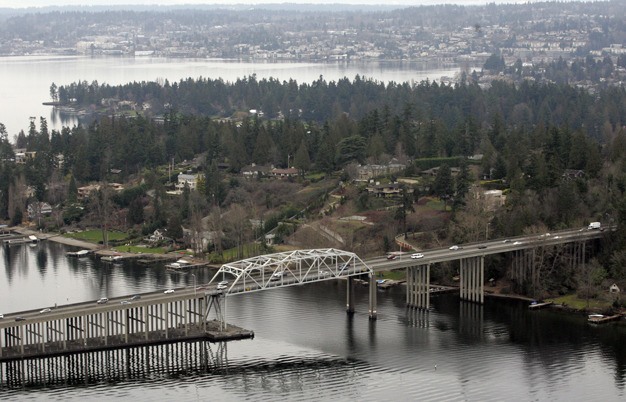It started as a big change for many drivers, but it’s now a part of the everyday commute. All-electronic tolling on the State Route 520 floating bridge will mark its one-year anniversary on Dec. 29.
As tolling reaches its first anniversary, SR-520 traffic and revenue continue to meet projections and are on the way to providing more than $1 billion in funding to help pay for the construction of a new bridge. Traffic is adjusting to variable tolls and settling into a new normal.
“We faced challenges along the way, but through hard work and dedication, SR-520 tolling is a success,” said Craig Stone, assistant secretary for the Washington State Department of Transportation, Toll Division. “Thanks to early tolling, we are already collecting revenue to fund the ongoing construction of a replacement bridge. Moreover, variable tolling is giving drivers a more reliable trip across the bridge. We are right on target.”
Before tolling began, forecasts anticipated an initial 48 percent drop in traffic volume on SR-520. That projection matched actual traffic at the start of tolling but as expected, volume has steadily returned. SR-520 bridge traffic is now about 70 percent of pre-toll levels. Revenue is also on track. Since Dec. 29, 2011, SR-520 tolls have generated approximately $50 million in gross revenue.
Tolling is exceeding other expectations as well. Currently, 84 percent of all trips across the SR-520 bridge are paid with a Good To Go! account, about 12 percent higher than the original forecast of 72 percent. Through the end of November, there have been more than 18 million tolled trips on SR-520.
“More SR-520 drivers are paying with Good To Go! and as a result, we’re mailing fewer toll bills,” Stone said. “It’s been a team effort, and it’s clear drivers have helped contribute to our success. A Good To Go! account is the best way to pay tolls – and even if you’ve received a toll bill, you can still set up an account to pay a lower toll rate.”
Stone also noted that SR-520 variable tolling is a successful traffic management tool as some drivers are adjusting their trip times to off-peak hours to take advantage of lower toll rates. Others took advantage of increased transit service and now take the bus instead of driving. The shifting and rebalancing of traffic saves SR-520 drivers about five minutes during peak period trips.
“We made a lot of progress this first year, so it’s more important now than ever that we stay our course,” Stone said. “We’re headed in the right direction, but remember this is just the first year of a 30-year plan.”
Transit and vanpools
King County Metro Transit and Sound Transit continue to see strong ridership growth on SR-520 across Lake Washington. Estimated daily ridership through September 2012 was nearly 19,000 – up a total of 25 percent since 2010, including a 9 percent increase since 2011.
“We’re carrying thousands of additional riders since tolling began, and surveys show more than one-third of them choose transit to save money on their commute,” said Kevin Desmond, Metro Transit General Manager. “Completing the HOV network across SR-520 supports growing transit demand and is part of our shared effort toward managing the state’s limited highway capacity.”
Before the start of tolling, King County Metro Transit and Sound Transit added 140 daily bus trips across the SR-520 floating bridge, bringing the week day service to nearly 750 bus trips on 19 routes today. Also, 179 vanpools now cross the lake on the SR-520 corridor, an increase of 50 vanpools – or 39 percent – since tolling started.
“Commuters are taking advantage of more choices to cross Lake Washington to ease the stress of their commute,” said Sound Transit CEO Joni Earl. “We’ve seen double-digit growth on our buses crossing SR-520 this year.”
Tolling on SR-520 is expected to raise $1 billion overall toward the $4.13 billion SR-520 bridge replacement and HOV program, which builds 12.8 miles of safety and mobility improvements from I-5 in Seattle to SR-202 in Redmond. The existing SR-520 floating bridge opened to traffic in 1963 and is vulnerable to sinking during a severe storm after weathering decades of wind and waves. The new bridge will better withstand storms and move more people across the lake with a new transit/HOV lane for buses and carpools in each direction. The floating bridge contract requires the new, six-lane SR-520 floating bridge to open to traffic by July 2015, but includes incentives for an earlier opening in December 2014.
For more information on tolling, visit www.wsdot.wa.gov/goodtogo/.


